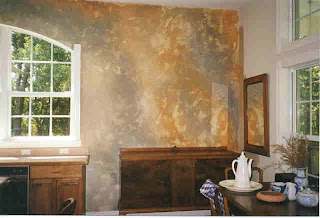
Tired of plain, boring walls? Faux finishes are a great way to jazz up your space with little cost or effort. Here are a few of the most popular finishes.
Sponging: Of all faux finish techniques, sponging is the easiest, even children can do a somewhat messy reproduction of this technique. In order to sponge, you must first paint the entire area one base color. After this coat dries, then you can take a sponge or even a plastic bag, dip it in paint, and apply the paint randomly to the walls. Although this is a random process, you want to be careful not to get any one area of the wall extremely dark or leave it extremely light or your eye will be drawn to that spot immediately. Sponging is very easy, and for all supplies usually costs between $50-$100, which may also include classes if you want to learn from the professionals.
Combing: Combing is a little more difficult. When combing, you use a squeegee with teeth to comb through the top layer of paint. As with sponging, you want to have a bottom layer so that when you comb there will be a matching layer beneath it. Using a combing technique is also very inexpensive, and you can use the squeegee to make wavy, zigzags, and other designs on the wall.
Glazing: Glazing is actually the product that you put over your first coat of paint. In order to glaze your walls correctly, you should take a class. You may be able to find a home improvement store that offers glazing classes or you may need to talk to a local interior decorator about classes, although these will likely be very expensive. Glazing places a transparent coat over the base coat of paint, making the wall look a bit shiny and transparent. You can use as many coats of glaze as you want to get the desired look.
Trompe-L'oeil: Trompe-L'oeil is French for "fool the eye." This finish fools the eye into thinking that the wall has a marble or granite finish. This is probably the most difficult finish to accomplish on your own. For creating the marble finish, you use a technique very much like sponging, but this one takes a bit more talent. Visit local stores to see if they have classes or tips on achieving this style.
These are the four primary types of faux finishes. The first two are fairly easy, while the latter two are significantly harder. Before attempting any of these, plan well so that you can estimate the cost, and visit your local hardware or design store for classes or helpful hints. Having a buddy to take classes with you or practice with you will make the experience more fun. You can even do one room in your house and then decorate a room in your buddy's house; the fun never ends!


























